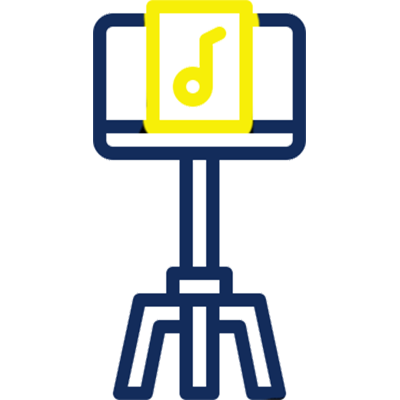Diploma in Sound Engineering
Diploma in
Sound Engineering
Sound Engineering Courses in Mumbai 2024
Welcome to our sound engineering courses design by School of Bollywood Music Mumbai specially for you, where you can find information about our top-notch sound engineering courses designed to help you master the art of audio production.
SBM’s sound engineering courses are ideal for individuals who are passionate about audio production and looking to make a career in the music, film, and television industry.
This sound engineering courses are taught by experienced professionals with years of experience in the audio production industry. They will provide you with hands-on training in the use of state-of-the-art equipment and software used by industry professionals.
At our sound engineering courses, we offer both online and on-campus training, so you can choose the format that best suits your learning needs. Our curriculum is constantly updated to keep up with the latest trends and technologies in the audio production industry. You will learn how to use digital audio workstations, microphones, mixers, and other equipment to create professional-quality audio productions.
Upon completion of our sound engineering courses, you will have the skills and knowledge necessary to launch a successful career in the sound engineering industry. Our students have gone on to work in a variety of profiles, including recording studios, film and television production companies, and live sound companies.
If you’re ready to take your passion for audio production to the next level, enroll in one of our sound engineering courses today!
Scope of Sound Engineering
Are you looking forward to make a career in sound engineering? Do you want to know more about what sound engineering is and the opportunities it presents?
Sound engineering is a field that has seen significant growth in recent years, thanks to the rise of digital media and advancements in technology. Sound engineers play a crucial role in the music, film, television, gaming, and broadcasting industries, ensuring that sound quality is top-notch.
Sound engineering involves recording, editing, mixing, and mastering sound to produce high-quality audio. This process requires a deep understanding of acoustics, sound theory, and the technical aspects of sound equipment. Sound engineers are responsible for capturing and enhancing sound, creating sound effects, and balancing audio levels to create a seamless listening experience for audiences.
Sound engineering presents a wide range of career opportunities. From music production to live sound mixing, film sound design to audio engineering for games, sound engineering is a versatile field that offers many exciting career paths. With the rise of podcasting, virtual and augmented reality, and other forms of immersive media, the demand for sound engineers is only growing.
To pursue a career in sound engineering, you’ll need a strong foundation in math, physics, and computer science, as well as a passion for music and sound. A diploma or certification course in sound engineering or a related field can be helpful, but many successful sound engineers have learned through hands-on experience and internships provided by School of Bollywood Music.
Role of Sound Engineer
A sound engineer designs and manages outputs and sound levels, takes care of handling physical sound equipment like microphones and amps and is responsible for the technical side of a live performance or a recording.
Among others, a sound engineer is responsible for the following activities:
- Sound Design
- Pitch Correction
- Recording
- Editing and Mixing
- Mastering
Career Opportunities in Sound Engineering
If you’re looking to step into the Sound Engineering field, then School of Bollywood Music is here to help you in a variety of fields such as advertising firms, animation, radio stations, movies, multimedia, gaming, and more.
Course Curriculum
This course will prepare the students to understand the concepts of Sound Engineering right from the Beginners to an Advanced level as per the Industry requirements.
- Vibrations to Sound
- Propagation of Sound
- Speed of Sound
- Waveforms – Sine, Square, Triangle, Sawtooth, Semisine
- Amplitude, Wavelength, Frequency, Calculation of Wavelength from frequency
- Human Hearing & Psychoacoustics
- Concept
- dB SPL, dBv, dBu, dBm
- Dynamic Range, Signal to Noise Ratio, Headroom
- Weighted Average (dBa, dBc)
- Boundary Effect
- Inverse Square Law – Demonstration using a Loudspeaker
- Impedance, Standard Operating Levels
- Concept
- Types – Vu, dBFS, PPM, LUFS, the ‘K’ System
- Phase, Stereo Spread, Spectral Analysis
- Applications
- Cables
- Connectors
- Applications
- Soldering Cables & Connectors (Practical)
- Using a Multimeter (Practical)
- Types
- Construction & Principle
- Polar Patterns
- Microphone Techniques
- Stereo Microphone Techniques
- Types – Active, Passive
- Drive Units
- Crossovers
- Cabinets
- Wiring & Setups
- Placement Setup & Calibration for Stereo, 5.1, 7.1, Auro 3D & Atmos
- Signal Path
- Analogue and Digital Consoles
- Inline and Split Consoles
- Channel Strips
- Input and Output Routing
- Auxes and Busses
- Master Section
- Control Surfaces
- A/D – D/A Conversion
- Sample Rate, Bit Depth, Bitrate
- Quantization, Dither
- Nyquist
- Digital Protocols
- Digital Cables
- Introduction
- Menus, Options and Preferences
- Input & Output Routing
- ASIO & CORE Audio Optimisation
- Toolbars & Transport
- Tracks – Audio, MIDI, Instrument
- DAW Console
- Signal Routing (internal & external)
- Bus & Aux
- Plugins
- Master Section
- Editing & Fades
- Keyboard Shortcuts
- Session Pool & File Management
- Importing & Exporting Files & Session
- Rendering Options
- Introduction to Acoustics
- Absorption, Diffusion, Reflection
- Isolation
- Room Modes
- RT-60
- Sepermeryer Ratios
- Studio Construction – Walls and Partitions
- Introduction to Acoustics
- Absorption, Diffusion, Reflection
- Isolation
- Room Modes
- RT-60
- Sepermeryer Ratios
- Studio Construction – Walls and Partitions
- Design Layout
- Sound Proofing,
- Acoustic Treatment – Panels
- Wiring Layout for Audio
- Wiring Layout for Electricals
- Electrical Load Distribution and Circuits
- Door and Windows
- Air Conditioning
- Room Calibration
- Studio Construction Project (Virtual)
- Microphone Placement Techniques (Practicals)
- Input Gain (Consoles & Preamps)
- Lead Vocal
- Backing Vocals & Chorus
- String Instruments
- Wind Instruments
- Percussion Instruments
- Drums
- Speaker (Guitars & Bass)
- Studio Session Management
- Dynamics
- EQ
- Reverbs
- Delay
- Phasing
- Flanging
- Distortion
- Stereo Spread
- Gain and Amplification
- Parallel Processing
- Signal Drive
- Saturation
- Concept
- Concept of Balance
- Levels – Dynamic Range – Using Compression and Gain
- Tonal – EQ
- Ambience – Reverb
- Modulation – Delay, Flange, Phasing, Distortion
- Panorama
- Concept and PAN Law
- L-C-R Panning
- Mix in Mono
- Phase Consistency
- The Master Channel
- Delivery of Mix and Formats
- Concept
- Mastering vs Mixing
- Prerequisites for a Mastering Session
- Audio Restoration
- Mastering Chain (Analogue and Digital)
- Stereo Imaging
- Volume, Loudness and Limiting
- Dither
- Delivery File Formats
- Understanding Live Sound
- Open Air vs Closed Space Acoustics
- Live Sound Equipments
- Line Array Systems
- Power Requirements
- Preparing and Managing a Live Session
- Concept
- Sound Design
- Foley effects
- Film and Video Formats
- Sync & Non Sync Effects, Digetic/Non-Diegetic Sounds, Leitmotif
- Track Laying – Practicals
- Foley – Practicals
- Sync, Non-Sync, Diegetic/Non-Diegetic Sounds
- Location Sound
- ADR
- Dialogue Cleaning
- Session Management
- Mixing – Stereo, 5.1, 7.1 & Dolby Atmos
- Delivery for OTT, Broadcast & Theatre
VIVAs : Interactive sessions where students will discuss their projects and demonstrate their understanding of key concepts.
Project Submissions: Students are required to submit projects that reflect their learning and skills gained throughout the course.
Assignments: Regular assignments will be evaluated to gauge ongoing progress and understanding of course material.
Course Curriculum
This course will prepare the students to understand the concepts of Sound Engineering right from the Beginners to an Advanced level as per the Industry requirements.
- Vibrations to Sound
- Propagation of Sound
- Speed of Sound
- Waveforms – Sine, Square, Triangle, Sawtooth, Semisine
- Amplitude, Wavelength, Frequency, Calculation of Wavelength from frequency
- Human Hearing & Psychoacoustics
- Concept
- Types – Vu, dBFS, PPM, LUFS, the ‘K’ System
- Phase, Stereo Spread, Spectral Analysis
- Applications
- Types
- Construction & Principle
- Polar Patterns
- Microphone Techniques
- Stereo Microphone Techniques
- Signal Path
- Analogue and Digital Consoles
- Inline and Split Consoles
- Channel Strips
- Input and Output Routing
- Auxes and Busses
- Master Section
- Control Surfaces
- Introduction
- Menus, Options and Preferences
- Input & Output Routing
- ASIO & CORE Audio Optimisation
- Toolbars & Transport
- Tracks – Audio, MIDI, Instrument
- DAW Console
- Signal Routing (internal & external)
- Bus & Aux
- Plugins
- Master Section
- Editing & Fades
- Keyboard Shortcuts
- Session Pool & File Management
- Importing & Exporting Files & Session
- Rendering Options
- Microphone Placement Techniques (Practicals)
- Input Gain (Consoles & Preamps)
- Lead Vocal
- Backing Vocals & Chorus
- String Instruments
- Wind Instruments
- Percussion Instruments
- Drums
- Speaker (Guitars & Bass)
- Studio Session Management
- Concept
- Concept of Balance
- Levels – Dynamic Range – Using Compression and Gain
- Tonal – EQ
- Ambience – Reverb
- Modulation – Delay, Flange, Phasing, Distortion
- Panorama
- Concept and PAN Law
- L-C-R Panning
- Mix in Mono
- Phase Consistency
- The Master Channel
- Delivery of Mix and Formats
- Concept
- Sound Design
- Foley effects
- Film and Video Formats
- Sync & Non Sync Effects, Digetic/Non-Diegetic Sounds, Leitmotif
- Track Laying – Practicals
- Foley – Practicals
- Sync, Non-Sync, Diegetic/Non-Diegetic Sounds
- Location Sound
- ADR
- Concept
- dB SPL, dBv, dBu, dBm
- Dynamic Range, Signal to Noise Ratio, Headroom
- Weighted Average (dBa, dBc)
- Boundary Effect
- Inverse Square Law – Demonstration using a Loudspeaker
- Impedance, Standard Operating Levels
- Cables
- Connectors
- Applications
- Soldering Cables & Connectors (Practical)
- Using a Multimeter (Practical)
- Types – Active, Passive
- Drive Units
- Crossovers
- Cabinets
- Wiring & Setups
- Placement Setup & Calibration for Stereo, 5.1, 7.1, Auro 3D & Atmos
- A/D – D/A Conversion
- Sample Rate, Bit Depth, Bitrate
- Quantization, Dither
- Nyquist
- Digital Protocols
- Digital Cables
- Introduction to Acoustics
- Absorption, Diffusion, Reflection
- Isolation
- Room Modes
- RT-60
- Sepermeryer Ratios
- Studio Construction – Walls and Partitions
- Introduction to Acoustics
- Absorption, Diffusion, Reflection
- Isolation
- Room Modes
- RT-60
- Sepermeryer Ratios
- Studio Construction – Walls and Partitions
- Design Layout
- Sound Proofing,
- Acoustic Treatment – Panels
- Wiring Layout for Audio
- Wiring Layout for Electricals
- Electrical Load Distribution and Circuits
- Door and Windows
- Air Conditioning
- Room Calibration
- Studio Construction Project (Virtual)
- Dynamics
- EQ
- Reverbs
- Delay
- Phasing
- Flanging
- Distortion
- Stereo Spread
- Gain and Amplification
- Parallel Processing
- Signal Drive
- Saturation
- Concept
- Mastering vs Mixing
- Prerequisites for a Mastering Session
- Audio Restoration
- Mastering Chain (Analogue and Digital)
- Stereo Imaging
- Volume, Loudness and Limiting
- Dither
- Delivery File Formats
- Understanding Live Sound
- Open Air vs Closed Space Acoustics
- Live Sound Equipments
- Line Array Systems
- Power Requirements
- Preparing and Managing a Live Session
- Dialogue Cleaning
- Session Management
- Mixing – Stereo, 5.1, 7.1 & Dolby Atmos
- Delivery for OTT, Broadcast & Theatre
VIVAs : Interactive sessions where students will discuss their projects and demonstrate their understanding of key concepts.
Project Submissions: Students are required to submit projects that reflect their learning and skills gained throughout the course.
Assignments: Regular assignments will be evaluated to gauge ongoing progress and understanding of course material.
Career Opportunities in Sound Engineering
Upon completion of the Diploma in Sound Engineering, Students will be prepared for several exciting roles within the Music and Sound industry, including :
Career Opportunities in Sound Engineering
Post-production Engineer
Radio Sound Engineer
Sound Effects Designer (Foley Artist)
Mixing Engineer
Mastering Engineer
Recording Engineer
Studio Acoustic engineer
Sound Editor
Educator
FAQ
No prior experience is required. The course is designed for beginners, though having a passion for music and sound will be helpful.
After completing the diploma, you can work as a sound engineer, music producer, mixing/mastering engineer, live sound technician, sound designer for films or games, or even start your own studio.
You will get hands-on experience with industry-standard equipment, including DAWs (Digital Audio Workstations), microphones, mixers and other professional audio gears as well as opportunities to work on real-world projects.
While it’s not mandatory to have your own equipment, having a basic setup (such as a computer with a DAW and headphones) for practice at home is recommended to enhance your learning experience.
Yes, there will be Vivas, assessments and practical exams including project submissions throughout the course to evaluate your progress.
Yes, upon successful completion of the course, you will be awarded a Diploma in Sound Engineering.
Yes, we offer flexible payment options with installment plans
Yes, students will have access to our professional studios for practice and project work.
We provide internships and placement opportunities for Studios, Production houses, and Record labels as well as projects for Films, OTT platforms, Television shows, Radio industry, etc.



